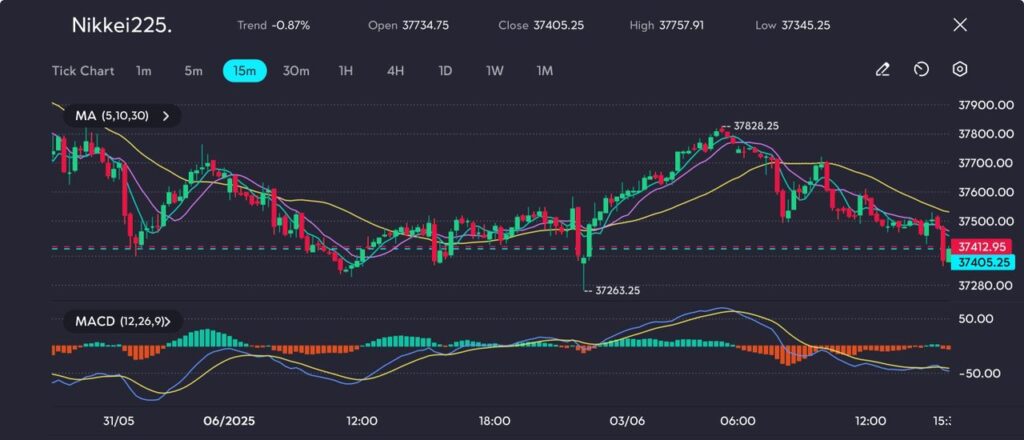
Key Points
- Nikkei225 shed 0.06%, closing at 37,446.81, logging its third straight daily decline.
- Yen rallied to ¥142.40/USD, weighing on major exporters and denting overseas profit outlooks.
The Nikkei 225 continued its downward drift on Tuesday, slipping into the close to extend a three-day losing streak. The index ended the session at 37,446.81, down 0.06%, after paring earlier gains. Despite a modest decline, sentiment across the Tokyo exchange remained cautious, with more stocks falling than rising — 122 decliners versus 98 advancers and five flat.
The biggest drag on the index came from a familiar source — the yen. The Japanese currency strengthened to a one-week high of ¥142.40 against the U.S. dollar on Tuesday. A firmer yen typically exerts pressure on exporters’ bottom lines by reducing the value of their foreign earnings.
Auto stocks bore the brunt of the currency move. Suzuki Motor plunged 4.51%, marking the sharpest loss among Nikkei constituents. Honda slipped 0.94%, and Toyota, the benchmark heavyweight, declined 0.59% despite domestic media reporting a potential $42 billion takeover of Toyota Industries, which rose a modest 0.77%.
These moves suggest markets were unimpressed by corporate deal headlines, instead remaining focused on macro concerns and the FX backdrop.
Trade Tensions: Markets Eye U.S. Deadline
Investors also turned cautious amid renewed global trade tensions. According to Reuters, the Trump administration has given countries until Wednesday to submit their final offers as part of ongoing trade negotiations. The aim is to accelerate progress across multiple fronts ahead of a self-imposed deadline just five weeks away.
The White House also signalled that Trump and China’s President Xi Jinping may speak later this week. This comes only days after Trump accused Beijing of violating terms of a previous trade rollback agreement.
This diplomatic uncertainty is unsettling equity markets, particularly in Japan, which relies heavily on exports to China and the U.S. Any signs of friction risk triggering retaliatory tariffs or disrupting supply chains — a scenario traders are eager to avoid.
While reduced volatility implies a calmer market, price action in the Nikkei remains fragile. Every recovery attempt this week has been met with consistent selling pressure. The 37,800–37,850 resistance zone remains a clear ceiling, while 37,250 acts as the next support floor.
Technical Analysis
The Nikkei 225 saw a strong bounce from the low of 37,263.25, climbing steadily to a session high of 37,828.25 on 3 June before losing momentum. The short-term rally was supported by rising 5/10/30 MAs, but the momentum has since faded, with price now falling back below the 30-period moving average.
Picture: Nikkei 225 fades after touching 37,828 peak; pressure mounts at 37,400 support amid renewed downside signals, as seen on the VT Markets app
MACD shows a clear bearish crossover and has entered negative territory, reinforcing the ongoing pullback. Price action is also testing a key horizontal support zone around 37,400, with pressure building as sellers return near the session close. A break below this level could expose the 37,260–37,300 region again.
While the broader trend remains volatile, bulls will need to reclaim the 37,600–37,800 range to regain control.
Unless the yen weakens or trade rhetoric improves, Japanese equities may continue under pressure this week. A dovish tone from U.S. trade negotiators or verbal intervention from Japanese officials could help stabilise sentiment, but risks remain skewed to the downside heading into the midweek session.










